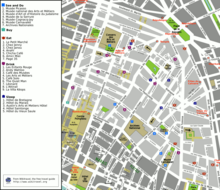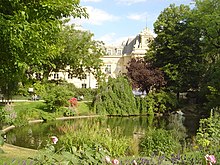3rd arrondissement (Paris)
|
3rd Arrondissement (Temple) Arrondissement municipal of Paris |
|
|---|---|
| Coordinates | 48 ° 51 '50 " N , 2 ° 21' 40" E |
| height | 35 m (32– 41 m ) |
| surface | 1.17 km² |
| Residents | 34,115 (Jan. 1, 2017) |
| Population density | 29,158 inhabitants / km² |
| INSEE code | 75103 |
| Post Code | 75003 |
| Website | mairie3.paris.fr |
| structure | |
| Quarters |
|
The 3rd arrondissement of Paris , the Arrondissement du Temple , is largely a residential area in the northeast of the city center. The settlement took place in the 13th and 14th century under Charles V instead. The oldest surviving houses, however, date from the 16th century . A large part of the arrondissement is occupied by the so-called Marais .
Geographical location
The 3rd arrondissement is on the right bank of the Seine , but is completely surrounded by other arrondissements. In the north it borders on the 10th arrondissement , in the east on the 11th arrondissement , in the south on the 4th arrondissement and in the west on the 1st and 2nd arrondissement .
The arrondissement takes its name from the " Temple ", the area of the Knights Templar, whose buildings have been destroyed there.
Quarter in the 3rd arrondissement
The arrondissement consists of the following four districts:
- District des Arts-et-Métiers
- District des Enfants-Rouges
- Quarters of the Archives
- Sainte-Avoye district
According to the official census of Parisian neighborhoods, these are quarters 9 to 12.
Demographic data
With 34,250 registered residents on an area of 1.17 km², the 3rd arrondissement makes up 1.6% of the total population of the city. The densely populated arrondissement has a population density of 29,300 inhabitants / km².
The inhabitants are distributed across the districts as follows:
- Arts et Métiers: 9580 inhabitants
- Enfants Rouges: 8560 inhabitants
- Archives: 8600 inhabitants
- Saint-Avoye: 7500 inhabitants
Politics and administration
town hall
The town hall of the 3rd arrondissement is located in the Temple, built in 1862, at Rue Eugène Spuller 2, 75003 Paris, phone: 01/53 01 75 03.
mayor
Mayor has been Pierre Aidenbaum (born May 3, 1942), a member of the French socialist party Parti socialiste (PS) , since 1995 .
Attractions
See also: List of Monuments Historiques in the 3rd Arrondissement (Paris)
- Conservatoire des arts et métiers (arts and crafts school) and the Musée des arts et métiers in the former abbey of St-Martin-des-Champs
- Gate of the Hôtel de Clisson (16th century), today the side entrance of the Hôtel de Soubise , rue des Archives
- Hôtel de Carnavalet (1548–1560), houses the Musée de l'Histoire de Paris (Museum of Paris City History)
- Hôtel Donon (16th to 18th centuries), houses the Musée Cognacq-Jay (works of art from the 18th century)
- Hôtels der Place des Vosges (1605–1612) with Victor Hugo's house (museum)
- Hôtel de Sully (1624–1630), houses the Center des monuments nationaux
- Hôtel de Saint-Aignan (1644–1650), houses the Musée d'art et d'histoire du Judaïsme (Museum of the Art and History of Judaism)
- Hôtel Guénégaud (1648–1651?), Houses the Musée de la Chasse et de la Nature (Hunting Museum)
- Hôtel Salé (1656), houses the Picasso Museum
- Hôtel Libéral Bruant (1685), houses an art gallery
- Hôtel de Saint-Fargeau (1686), belongs to the Museum of Paris City History
- Hôtel de Soubise (1705–1709), houses the National Archives and the Musée de l'Histoire de France (Museum of the History of France)
- Hotel de Rohan -Strasbourg (1708)
- Hôtel d'Hallevyl (early 18th century)
- Hôtel Duret de Chevry, there is since 1994 German Historical Institute located
Transport and infrastructure
Major roads
The Rue du Temple and the Rue de Beaubourg cross the district in a central location from south to north and north to south, while the Rue Reaumur together with the Rue de Bretagne runs through it from west to east. Furthermore, numerous important traffic axes meet at the Place de la République in the extreme northeast of the third arrondissement, of which the Boulevard du Temple (further down the Boulevard des Filles du Calvaire and Boulevard Beaumarchais ) is the eastern border and the Boulevard Saint-Martin is the northern border of the Mark the district. In the west, however, it is limited by the Boulevard de Sébastopol . Finally, the Rue de Turbigo connects the Place de la République with the Jardin des Halles in the first arrondissement.
Important places
Metro lines
The Métrolinie 11 crosses the district from southwest to northeast and connects it with the large transfer stations Châtelet (in the first arrondissement) and République . The République station is located in the northeast of the district and is also served by lines 3 , 5 and 9 , as well as by Metro line 8 , which follows the eastern border of the arrondissement to the south. Métrolinie 4 also touches the western border of the district.
Important churches
Green areas
- Square du Temple (across from City Hall)
- Jardin Saint-Aignan
Literary meaning
The Nestor Burma novel Fièvre au Marais (Eng. Marais Fever ) by Léo Malet is set in the 3rd arrondissement.





